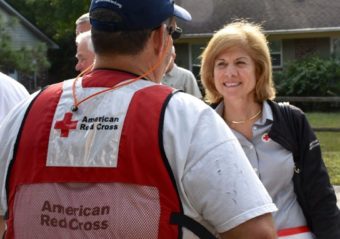Red Cross Provides Relief from Historic Floods
The American Red Cross continues to work around the clock to help people across the Carolinas, where unprecedented rainfall and flooding destroyed homes and left thousands of residents without water or power earlier in the month. Hardest hit was South Carolina, and just over the weekend, another round of rainfall impacted already saturated and flooded areas. Some rivers remain high along South Carolina’s coast, but experts believe the worst of the flooding has ended, and residents have begun the long process of cleaning up.
Since the rain storms began, nearly 800 Red Cross workers, more than 50 response vehicles and shelter supplies for 5,000 people have been mobilized to assist in South Carolina. On Sunday night, more than 300 people found a safe place to stay in 15 Red Cross and community shelters.
Eva Gadsen, 72, of Columbia, South Carolina, volunteered with the Red Cross a decade ago after Hurricane Katrina impacted New Orleans and surrounding areas. Now she is dealing with the massive flooding that destroyed her own home and placed her in a Red Cross shelter for five days.
“If it wasn’t for Red Cross, I really don’t know what would happen here,” she said. Eva received help for her blood pressure, in addition to other assistance at a Red Cross shelter.
Throughout areas where flood waters have receded, Red Crossers are working out of emergency response vehicles to deliver relief and cleanup supplies, such as rakes, shovels, work gloves, bleach and buckets, to help individuals and families clean out their homes. Red Cross disaster workers are also helping with damage assessments – going door-to-door in affected communities to determine what help people need in the recovery process.
Red Cross mental health professionals are providing emotional support for impacted individuals, and caseworkers are meeting one-on-one with people to help them with their recovery and connect them with additional resources. We are working closely with government officials and community partners to ensure people receive the help they need in South Carolina.
It will take weeks for people to return to their daily lives in the Palmetto State —and even longer to fully recover. But with your support, the Red Cross will remain a constant presence to help residents rebuild their lives and become more resilient to future crises.
Responding to Disasters Every Day
Beyond the Carolinas, the Red Cross is busy assisting people in communities across the country. In fact, about every eight minutes, the Red Cross responds to a disaster—from home fires to severe storms, floods and wildfires.
In Texas, the Red Cross is also coordinating flooding response efforts after heavy rains impacted the region late last week. And in Illinois, the Red Cross was active at the Chicago Marathon over the weekend, supporting family reunification services and emergency contact communications for race participants and spectators.
In the West, the 2015 wildfire season has been one of the worst on record, burning more than 9 million acres to date. The Red Cross continues to coordinate massive relief efforts across multiple states, including most recently in Wyoming, to provide shelter, cleanup supplies and support services for people impacted by the fires.
Our response to these and other disasters is made possible by the generosity of our donors, whose support of Disaster Relief enables us to be there for those we serve. We ask you to join in this commitment.
How You Can Help
Help people affected by disasters like floods in South Carolina by making a gift to American Red Cross Disaster Relief. Your gift enables the Red Cross to prepare for, respond to and help people recover from disasters big and small.
Visit redcross.org/donate, or call 1-800-REDCROSS. Contributions may also be sent to your local Red Cross chapter, or to the American Red Cross, P.O. Box 26902, Lehigh Valley, PA 18002-6902.
Stay Safe After Flooding
Floods are among the most frequent and costly natural disasters.
Because they can occur suddenly, the Red Cross urges people to download the free Red Cross Emergency App for mobile devices and follow these flood recovery safety tips:
- Before entering your home, look outside for loose power lines, damaged gas lines, foundation cracks or other damage.
- Parts of your home may be collapsed or damaged. Approach entrances carefully. See if porch roofs and overhangs have all their supports.
- Materials such as cleaning products, paint, batteries, contaminated fuel and damaged fuel containers are hazardous. Check with local authorities for assistance with disposal to avoid risk.
- During cleanup, wear protective clothing, including rubber gloves and rubber boots.
- Make sure your food and water are safe. Discard items that have come in contact with floodwater, including canned goods, water bottles, plastic utensils and baby bottle nipples. When in doubt, throw it out!
Visit redcross.org/prepare/disaster for more disaster safety tips.


